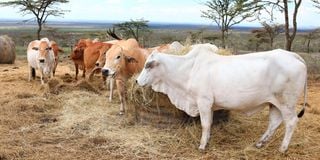Premium
In the wake of climate change, pastoralists must adapt or perish

Boran cattle at Ol Pejeta conservancy in Laikipia County on April 8, 2021. Crosses of Boran and Sahiwal or mixes of Zebu fatten and mature faster for higher value.
Almost every year, pastoralists in the arid and semi-arid lands (Asals) agonise over the loss of their livestock due to drought.
The problem is predictable but the recurrent nature of the catastrophe has almost made it normal in the country.
As human population increases, the pastoralists are finding themselves with less land to disperse their animals to in search of pasture and water during the dry season. Eventually, they will have to be settled in specific places.
Again, as more children enrol in schools and progress in the education system, the pastoral system will be starved of the labour required to move long distances with the animals. In short, the pastoral economy and way of farming is endangered and is no longer suitable to the rapid development trend.
Interestingly, Kenyans from non-pastoralist communities are settling in Asals and taking along their sedentary way of life. They are finding commercial livestock farming a good proposition in the areas as they understand the livestock economy and the large demand for meat.
Mutton production
Last week, I visited Sam, one such farmer in Laikipia County. His aim is to set up a beef and mutton production farm. He is lucky because the farm has a long frontage of the permanent Ewaso Narok River. Previous owners of the farm have raised cattle, sheep and goats for many years on open grazing. The farmer intends to set up his operation as a commercial fattening farm, otherwise called livestock feedlot.
Sam is a first-time livestock farmer but is passionate and determined to venture and succeed in commercial livestock production. When he called me, he said he had bought some cattle and sheep that he needed my advice on the quality and management. He was concerned some of the cows looked rather small and wondered if they would actually grow big and put on weight.
My first observation on the farm was that it was well laid out. There were a few pieces of farm machinery including a brand new tractor. Vast sections of the land had already been tilled awaiting planting of Boma Rhodes grass and maize for fodder. Sam was in the process of buying a water pump and a generator.
The sheep herd comprised about 80 animals of the Dorper breed, some with a mixture of the Red Maasai. I commended the Dorper but advised he should obtain two purebred Dorper rams to raise to upgrade the sheep to almost pure Dorper status.
Dorper is a highly adaptive and fast-growing breed of meat sheep developed by South Africa from the Dorset horned sheep and the Persian Black head Sheep. In pure state, the head and neck are charcoal black and the body is snow white, long, compact and rectangular. The sheep is big, up to 150kg for males, and a fast-grower. Lambs attain 40kg at four months of age. It mainly feeds on grass to produce high quality lean meat with a tasty flavour. Sam’s sheep were in good body condition and health.
Many people mistake the Dorper with the Somali Blackhead or fat-tailed sheep. This sheep has a fatty tail with a thin tail tip. It is small and less muscular than the Dorper
Next I looked at the cattle. The farm had 50 head of cattle all being Small East African Zebu. Some of the cattle were victims of inbreeding and would never attain a live weight of more than 250kg even in their prime.
The Small East African Zebu is a common breed in many parts of the Asals. For better performance of the rangelands, farmers should upgrade the breed with Boran or Sahiwal, which are fast-growing animals that pack in a lot of meat. They easily attain 400kg live weight at 18 to 22 months in a feedlot.
Big body frames
I advised Sam to fatten the animals that he already had, sell all of them and replace with crosses and mixes from Sahiwal, Boran and large Zebus. Animals selected for commercial fattening should be mature with big body frames. They should preferably have a live weight of 220 to 300kg and capable of quickly building to 450 to 500kg within 90 to 120 days of proper feeding.
Our next stop was the Rumuruti livestock market to have a practical feel on animal selection. There were very few large Zebus, Sahiwal and Boran crosses or mixes at the market. However, every livestock broker touted the animals he was selling to be the best. I also demonstrated to Sam the clear difference between the Dorper and the Somali Blackhead sheep.
Our final stop was Joel’s fodder farm in Ol Joro Orok in Nyandarua County where Sam was to buy good quality oat and grass hay for his animals. To demonstrate the quality of the hay, Joel displayed to us his Boran-Sahiwal cross heifer in top body condition that he had bought from the Rumuruti market about four months earlier in very poor body condition.
Joel’s farm was covered with blocks of oat and hay grasses that he grows, harvests and sells to livestock farmers. He said he usually has the hay all year round because the area is always wet. I was impressed by the level of mechanisation of Joel’s farm with various fodder farm machinery.





